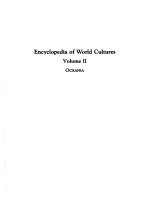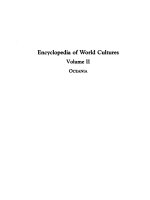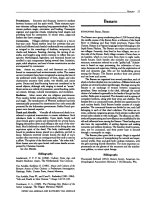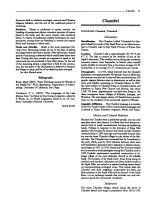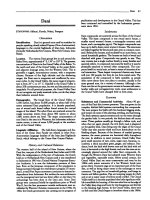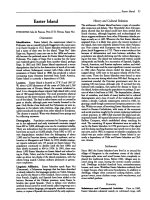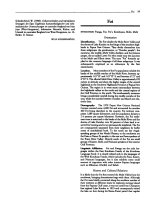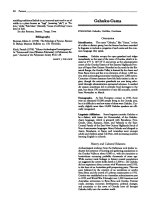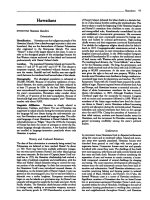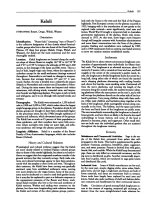Encyclopedia of World Cultures Volume 2 - Oceania - D potx
Bạn đang xem bản rút gọn của tài liệu. Xem và tải ngay bản đầy đủ của tài liệu tại đây (1.13 MB, 10 trang )
Dani
43
pacification
and
development
in
the
Grand
Valley.
This has
been
continued
and
intensified
by
the
Indonesian
govern-
ment
since
1962.
ETHNONYMS:
Akhuni,
Konda,
Ndani,
Pesegem
Orientation
Identification.
Dani
is
a
general
term
used
by
outsiders
for
peoples
speaking
dosely
related
Papuan
(Non-Austronesian)
languages
in
the
central
highlands
of
Irian
Jaya,
Indonesia
(formerly
Netherlands
New
Guinea,
West
New
Guinea,
Irian
Barat).
Location.
The
various
Dani
groups
live
in
and
around
the
Balim
River,
approximately
4°
S,
138°
to
1390
E.
The
greatest
concentration
of
Dani
is
in
the
Grand
Valley
of
the
Balim.
To
the
north
and
west
of
the
Grand
Valley,
in
the
upper
Balim
and
adjacent
drainage
areas,
live
the
Western
Dani.
This
is
generally
a
rugged,
mountainous
country,
with
a
temperate
climate.
Because
of
the
high
altitude
and
the
sheltering
ranges,
the
Dani
area
is
temperate
and
unaffected
by
mon-
soon
cycles.
In
the
Grand
Valley,
the
mean
range
of
tempera-
ture
is
from
26°
C
to
15°
C.
Rainfall
in
the
Grand
Vailey
is
about
208
centimeters
per
year,
but
wet
and
dry
periods
occur
irregularly.
For
all
practical
purposes,
the
Grand
Valley
Dani
do
not
recognize
any
yearly
seasonal
cycles,
nor
do
they
shape
their
behavior
around
them.
Demograhy.
The
broad
floor
of
the
Grand
Valley,
at
1,500
meters,
has
about
50,000
people,
or
about
half
of
the
entire
estimated
Dani
population.
It
is
densely
populated,
one
of
several
such
broad
valleys
found
across
the
central
ranges
of
the
island.
The
other
Dani
are
scattered
across
the
rough
mountain
terrain
from
about
900
meters
to
about
1,800
meters
above
sea
level.
The
major
concentration
of
non-Dani
in
the
area
is
in
Wamena,
the
Indonesian
adminis-
trative
center,
a
town
of
some
5,000
people
at
the
southern
end
of
the
Grand
Valley.
linguistic
Affliation.
The
half-dozen
languages
and
dia-
lects
of
the
Great
Dani
Family
are
related
to
other
Non-
Austronesian
language
families
of
the
Irian
Jaya
Highlands
Stock,
which
belongs
to
the
Trans-New
Guinea
Phylum.
History
and
Cultural
Relations
The
western
half
of
the
island
of
New
Guinea,
where
the
Dani
live,
was
part
of
the
Netherlands
East
Indies
until
1949.
With
the
independence
of
the
rest
of
Indonesia,
the
Dutch
held
on
to
Netherlands
New
Guinea
until
it
was
transferred
to
Indonesia
in
1963
via
a
United
Nations
Temporary
Execu-
tive
Authority.
It
is
now
the
Indonesian
province
of
Irian
Jaya.
Even
as
the
Javanese
component
of
the
population
is
being
increased
through
the
resettlement
program
(Transmi-
grasi),
a
small
Free
Papua
movement
continues
to
demand
in-
dependence
from
Indonesia.
But
neither
the
new
settlements
nor
the
insurgents
have
had
any
direct
effect
on
the
Dani.
No
archaeology
has
been
done
in
the
Dani
area.
Some
Dani
groups
were
contacted
briefly
by
expeditions
prior
to
World
War
II,
but
the
first
permanent
outside
settlements
were
es-
tablished
by
Western
Christian
missionaries
in
the
1950s.
By
1960,
the
Dutch
government
was
carrying
out
its
program
of
Settlements
Dani
compounds
are
scattered
across
the
floor
of
the
Grand
Valley.
The
basic
compound
is
one
round
men's
house,
a
smaller
round
women's
house,
a
rectangular
common
cook
house,
and
a
rectangular
pig
sty.
The
largest
compounds
may
have
up
to
half
a
dozen
more
women's
houses.
The
structures
are
linked
together
by
fences
and
open
onto
a
common
court-
yard.
Behind
the
houses,
and
enclosed
by
an
outer
fence,
are
casual
household
gardens.
The
houses
are
built
of
wood
and
thatched
with
grass.
Compounds
vary
greatly
in
size.
They
may
contain
just
a
single
nuclear
family
or
many
families
and
assorted
others.
A
compound
may
stand
by
itself
or
it
may
be
physically
attached
to
several
other
compounds.
The
com-
pound
itself
is
a
social
unit,
at
least
in
terms
of
intensity
of
so-
cial
interaction.
These
largest
compound
dusters
may
house
well
over
100
people,
but
they
do
not
form
social
units.
The
population
of
the
compound
is
fairly
unstable,
as
people
often
move
about
from
one
place
to
another,
usually
in
the
same
general
area,
for
a
variety
of
reasons.
Although
a
few
Dani
now
live
at
the
government
centers
in
houses
with
sawn-
lumber
walls
and
corrugated-zinc
roofs,
most
settlements
in
the
Grand
Valley
have
changed
little
in
forty
years.
Economy
Subsistence
and
Co
amercial
Activities.
About
90
per-
cent
of
the
Dani
diet
is
sweet
potatoes.
They
are
grown
in
the
complex,
ditched
field
systems
surrounding
the
compounds.
The
men
prepare
the
fields
with
fire-hardened
digging
sticks,
and
women
do
most
of
the
planting,
weeding,
and
harvesting.
The
ditch
systems
capture
streams
and
run
the
water
through
the
garden
beds.
In
wet
periods,
the
ditches
drain
off
excess
water.
These
gardens
usually
go
through
a
fallow
cycle,
and
when
they
are
again
cleared,
the
rich
ditch
mud
is
plastered
on
the
garden
beds.
Dani
living
near
the
edges
of
the
Grand
Valley
may
also
practice
slash
and
burn
horticulture
on
the
flanking
slopes.
Because
of
the
absence
of
marked
growing
seasons,
the
sweet
potatoes
are
harvested
daily
throughout
the
year.
In
addition
to
sweet
potatoes,
Grand
Valley
Dani
grow
small
amounts
of
taro,
yams,
sugar
cane,
bananas,
cu-
cumbers,
a
thick
succulent
grass,
ginger,
and
tobacco.
Pan-
danus,
both
the
kind
with
brown
nuts
and
the
kind
with
red
fruit,
is
harvested
in
the
high
forests,
and
now
the
trees
are
in-
creasingly
planted
around
the
valley
floor
compounds.
Al-
though
the
Western
Dani
had
adopted
many
Western
fruits
and
vegetables,
especially
maize,
before
actual
contact,
the
Grand
Valley
Dani
are
more
conservative
and
even
by
the
1980s
only
minor
amounts
of
a
few
Western
foods
were
grown
there.
Domestic
pigs
are
an
important
part
of
the
Dani
diet,
as
well
as
being
major
items
in
the
exchanges
at
every
ceremony.
The
pigs
live
on
household
garbage,
and
forage
in
forests
and
fallow
gardens.
Pigs
are
tempting
targets
for
theft
and
so
are
a
major
cause
of
serious
social
conflict.
The
Grand
Valley
itself
is
so
densely
populated
that
little
significant
wild-
life
is
available
for
hunting.
A
few
men
who
live
on
the
edge
of
the
Valley
keep
dogs
and
hunt
for
tree
kangaroos
and
the
like
in
the
flanking
high
forests.
In
the
Grand
Valley,
there
were
no
fish
until
the
Dutch
began
to
introduce
them
in
the
1960s.
Dai
44
Dani
The
only
water
creatures
which
the
Dani
ate
were
crayfish
from
the
larger
streams.
Industrial
Arts.
Until
the
1960s,
when
metal
tools
were
introduced
by
outsiders,
the
Grand
Valley
Dani
tools
were
of
stone,
bone,
pig
tusk,
wood,
and
bamboo.
Ground
ax
and
adz
stones
were
traded
in
from
quarries
in the
Western
Dani
re-
gion,
and
the
Jale,
or
Eastern
Dani,
got
their
stones
from
even
further
east.
Other
tools
were
made
locally.
They
made
no
pottery
or
bark
cloth.
Gourds
were
used
for
water
containers
and
also
for
penis
covers.
String
rolled
from
the
inner
bark
of
local
bushes
was
used
extensively
to
make
carrying
nets,
wom-
en's
skirts,
and
ornaments.
Rattan
torso
armor
for
protection
against
arrows
was
made
by
Western
Dani
but
the
Grand
Val-
ley
Dani
neither
made
it
nor
traded
for
it.
Spears
and
bows
and
arrows
were
the
weapons
of
war.
The
arrows
were
un-
fletched,
with
notched,
barbed,
and
dirtied
(but
not
poi-
soned)
tips.
By
the
1980s,
cloth,
metal
axes,
knives,
and
shovels,
as
well
as
the
detritus
of
modem
life-cast-off
tin
cans
and
plastic
bottles-had
partially
replaced
traditional
Dani
crafts.
Trade.
Even
before
contact,
various
seashell
types
had
been
traded
up
from
the
coasts
of
the
island
into
the
entire
Dani
area.
Ax
stones
and
flat
slate
ceremonial
stones,
bird
of
paradise
feathers,
cassowary-feather
whisks,
and
spear
woods
were
traded
into
the
Grand
Valley
in
exchange
for
pigs
and
salt
produced
from
local
brine
pools.
Division
of
Labor.
Gender
and
age
are
the
major
bases
for
division
of
labor.
There
are
no
full-time
specialists;
but
there
is
some
spare-time
specialization.
A
few
people
are
known
as
expert
arrow
makers
or
curers.
Generally,
men
do
the
heavy
work
like
tilling
gardens
or
building
houses,
while
women
do
the
tedious
work
like
planting,
weeding,
harvest-
ing,
and
carrying
thatch
grass.
Men
weave
the
tight
shell
bands
used
in
ceremonies,
women
make
carrying
nets,
and
both
make
string.
Because
of
the
very
relaxed
atmosphere
between
men
and
women,
there
is
little
activity
totally
hid-
den
from
either
sex.
Land
Tenure.
Quite
informal
usage
rights
are
the
rule.
Al-
though
there
is
little
or
no
population
pressure
in
the
Grand
Valley,
the
extensively
ditched
sweet
potato
gardens
on
the
broad
valley
floor
do
represent
quite
a
considerable
labor
in-
vestment,
but
even
so,
rights
are
casually
and
informally
transferred.
Large
garden
areas
are
usually
farmed
by
men
of
a
single
sib
or
a
single
neighborhood.
Fields
are
controlled
by
men,
not
women.
Kinship
Kin
Groups
and
Descent.
The
Grand
Valley
Dani
have
exogamous
patrilineal
moieties
and
exogamous
patrilineal
sibs.
Some
sib
names
can
be
found
also
in
groups
outside
the
Grand
Valley
and
there
are
hints,
perhaps
remnants,
of
a
moiety
system
in
Western
Dani.
In
the
Grand
Valley,
people
are
born
into
the
sib
of
their
father,
but
at
birth
all
Grand
Valley
Dani
are
considered
to
be
of
the
wida
moiety.
Before
marriage,
those
whose
fathers
are
of
the
warya
moiety
'be-
come
waiya,"
the
boys
through
an
initiation
ceremony,
the
girls
without
ceremony.
The
chief
function
of
the
moieties
is
to
regulate
marriage.
Sibs
are
associated
with
one
or
the
other
moiety,
never
both.
There
are
sib-specific
bird
totems
and
food
taboos.
Local
segments
of
sibs
keep
their
sacred
objects
in
common,
store
them
in
the
men's
house
of
the
most
im-
portant
man,
and
hold
renewal
ceremonies
for
these
objects.
Grand
Valley
Dani
are
not
much
concerned
with
tracing
ge-
nealogy.
Common
sib
membership
is
assumed
to
mean
com-
mon
ancestry,
but
people
rarely
know
their
ancestors
more
than
a
couple
of
generations
back.
Kinship
Terminology.
The
Dani
have
Omaha-type
kin-
ship
terminology.
Marrage
and
Family
Marriage.
Weddings
take
place
only
at
the
time
of
the
great
pig
feast,
which
is
held
in
an
alliance
area
every
four
to
six
years.
Moiety
exogamy
is
invariably
observed.
Marriages
tend
to
take
place
between
neighbors,
if
not
within
a
neigh-
borhood
at
least
within
a
confederation.
Some
marriages
are
arranged
by
the
families,
while
others
are
love
matches
ar-
ranged
by
the
individuals.
Marriage
begins
a
series
of
rela-
tively
equal
exchanges
between
the
two
families,
which
con-
tinues
for
a
generation,
through
the
initiation
and
marriage
of
the
resulting
children.
These
exchanges
consist
of
pigs,
cow-
rie
shell
bands,
and
sacred
slate
stones.
Immediate
postmar-
ital
residence
is
patrilocal,
although
within
a
few
years
the
couple
is
likely
to
be
living
neolocally
within
the
neighbor-
hood
or
confederation
where
both
sets
of
parents
live.
Di-
vorce
is
fairly
easy,
but
long-term
separation
is
more
common.
At
early
stages
of
tension,
the
wife,
or
the
junior
wife,
moves
out
to
another
relative's
compound
for
a
time.
Nearly
half
the
men
are
involved
in
polygynous
marriages.
The
Grand
Valley
Dani
have
remarkably
little
interest
in
sexuality.
A
postpar-
tum
sexual
abstinence
period
of
around
five
years
is
generally
observed
by
both
parents
of
a
child.
The
minority
of
men
who
are
involved
in
polygynous
marriages
may
have
sexual
access
to
another
wife,
but
for
most
men
and
all
women
there
are
no
alternative
outlets
nor
any
apparent
increased
level
of
stress
for
those
subject
to
the
abstinence.
Ritual
homosexuality
is
absent.
This
extraordinarily
long
postpartum
sexual
absti-
nence
has
not
been
reported
among
the
Western
Dani.
Domestic
Unit
It
is
easy
to
identify
both
nuclear
families
and
extended
families,
but
these
units
are
usually
less
impor-
tant
than
the
compound
group
as
a
whole.
Inheritance.
There
is
little
real
property
to
inherit.
As
boys
grow
up
they
join
with
their
fathers
in
maintaining
the
sacred
objects
held
by
the
local
patrilineal
sib
segment.
In
a
more
general
sense,
sons-and
to
some
extent
daughters-of
the
wealthier
and
more
powerful
men
benefit
from
their
father's
position.
Socialization.
Child
rearing
is
very
permissive.
Toilet
training
is
casual.
Children
are
rarely,
if
everphysically
disci-
plined
and
even
verbal
admonishment
is
rare.
There
is
almost
no
overt
instruction.
Children
learn
by
participating
but
not
by
asking
questions.
Since
the
late
1960s,
government-
sponsored
schools,
usually
run
by
missionaries,
have
been
teaching
more
and
more
Dani
children
to
read
and
write
in
Indonesian.
Sociopolitical
Organization
Social
Organization.
In
the
Grand
Valley
the
largest
terrn
torial
sociopolitical
unit
is
the
alliance,
with
several
thousand
people.
Warfare
and
the
great
pig
feast
are
organized
at
the
Dani
45
alliance
level.
Each
alliance
is
composed
of
several
confedera-
tions,
which
are
also
territorial
units
containing
from
several
hundred
up
to
a
thousand
people.
Confederations
are
usually
named
for
the
two
sibs
with
the
strongest
representation.
Many
ceremonies,
and
the
individual
battles
that
constitute
warfare,
are
organized
on
a
confederation
level,
initiated
by
the
confederation-level
leaders.
Within
the
confederation
territory
there
are
usually
recognizable
neighborhoods,
but
these
are
not
true,
functioning
social
units.
Contiguous
clus-
ters
of
compounds,
also
making
up
physical
units,
are
not
so-
cial
units.
Each
individual
compound,
although
lacking
for-
mal
organization,
is
the
venue
of
the
most
intense
social
interaction.
Moieties
and
sibs
are
nonterritorial,
unilinear
de-
scent
groups
which
crosscut
the
territorial
units.
The
two
moieties,
being
exogamous,
are
represented
in
every
com-
pound.
A
couple
of
dozen
sibs
may
be
represented
in
a
con-
federation,
even
though
it
is
dominated
by
members
of
only
a
few
sibs.
In
Dani
areas
outside
the
Grand
Valley,
the
confed-
eration
is
the
largest
unit
and
alliances
are
absent.
Political
Organization.
Dani
leadership
is
relatively
infor-
mal,
vested
in
nonhereditary
"big-men"
(that
term
is
used
in
Dani).
The
leaders
of
the
confederation
and
the
alliance
are
well
known,
but
they
are
not
marked
by
special
attire
or
other
artifacts.
They
are
men
of
influence,
not
power,
and
they
emerge
as
leaders
through
consensus.
Leaders
take
responsi-
bility
for
major
ceremonies
and
for
initiating
particular
bat-
tles.
The
leader
of
the
alliance
announces
the
great
pig
feast
and
directs
the
final
alliance-wide
memorial
ritual.
Leaders
are
believed
to
have
unusually
strong
supernatural
powers.
Social
ControL
Grand
Valley
Dani
have
no
formal
judicial
institutions,
but
leaders,
using
their
influence,
can
resolve
disputes
up
to
the
confederation
level,
assessing
compensa-
tion
for
pig
theft
and
the
like.
But
beyond
the
confederation,
even
within
a
single
alliance,
disputes
often
go
unresolved
be-
cause
rarely
does
anyone's
influence
extend
across
confedera-
don
boundaries.
Norms
were
not
expressed
in
explicit
formal
statements.
Now
the
Indonesian
police
and
army
have
taken
over
dispute
settlement.
Conflict.
Until
the
early
1960s,
interalliance
warfare
was
endemic
in
the
Grand
Valley.
Each
alliance
was
at
war
with
one
or
more
of
its
neighbors.
Wars
broke
out
when
the
accu-
mutation
of
unresolved
disputes
became
too
great.
A
war
could
last
for
a
decade.
Then,
as
the
original
grievances
began
to
be
forgotten,
fighting
would
slack
off.
At
that
point
an
alli-
ance
that
had
built
up
unresolved
interconfederation
griev-
ances
could
split
apart,
resulting
in
re-formation
of
alliances
and
ties,
whether
of
war
or
of
peace,
between
alliances.
The
confederation
itself
remained
relatively
stable,
but
alliance
groupings
shifted.
It
was
the
ritual
phase
of
war
that
lasted
for
years.
Once
begun,
it
was
fueled
by
the
belief
that
ghosts
of
the
killed
demanded
revenge.
Since
both
sides
were
Dani,
with
virtually
the
same
culture,
and
the
same
ghost
beliefs,
the
killing
went
on,
back
and
forth.
In
the
ritual
phase
of
war,
formal
battles
alternated
with
surprise
raids
and
ambushes
at
the
rate
of
about
one
incident every
couple
of
weeks.
Battles
might
bring
1,000
armed
men
together
for
a
few
hours
on
a
battleground.
A
raid
might be
carried
out
by
a
handful
of
men
slipping
across
no-man's-land
hoping
to
kill
an
unsuspecting
enemy.
But
a
war would
begin
with
a
brief,
secular
outburst
that
had
no
connection
with
unplacated
ghosts.
Some
con-
federations
in
an
alliance
would
turn
against
their
supposed
allies
and
make
a
surprise
attack
on
villages,
killing
men,
women,
and
children
indiscriminately.
The
alliance
would
be
broken
apart,
and
both
sides
would
withdraw
from
a
kilo-
meter-wide
area,
which
would
become
a
fallow
no-man's-land
on
which
the
periodic
battles
of
the
ritual
phase
of
war
would
be
fought.
By
the
mid-1960s,
the
Dutch
and
then
the
Indo-
nesians
were
able
to
abolish
formal
battles
of
the
ritual
phase
of
war,
but
sporadic
raids
and
skirmishes
continue
in
isolated
parts
of
the
Grand
Valley.
Religion
and
Expressive
Culture
Religious
Beliefs.
The
Grand
Valley
Dani
explain
most
of
their
ritual
as
placating
the
restless
ghosts
of
their
own
recent
dead.
These
ghosts
are
potentially
dangerous
and
cause
mis-
fortune,
illness,
and
death.
Thus,
attempts
are
made
to
keep
them
far
off
in
the
forest.
Dani
also
believe
in
local
land
and
water
spirits.
In
the
1950s,
the
Western
Dani
region
experi-
enced
nativistic
cargo
cult-like
movements
that
swept
ahead
of
the
Christian
missionary
advance.
But
these
movements
had
no
effect
on
the
more
conservative
Grand
Valley
Dani.
Now,
in
the
1990s,
many
Dani-Grand
Valley
as
well
as
others-are
practicing
Christians.
Islam,
the
majority
reli-
gion
of
the
larger
nation,
was
not
able
to
cope
with
Dani
pigs
and
has
had
little
success
there.
Religious
Practitioners.
Various
people,
mainly
men,
are
known
for
their
magical
curing
powers.
Ritual
as
well
as
secu-
lar
power
is
combined
in
the
leaders
at
various
levels.
Leaders
of
alliances
seem
often
to
have
exceptionally
strong
and
even
unique
powers.
Ceremonies.
During
the
time
of
war,
ceremonies
were
fre-
quent.
Battles
themselves
could
be
seen
as
ceremonies
di-
rected
at
placating
the
ghosts.
There
were
also
ceremonies
celebrating
the
death
of
an
enemy
or
funerals
for
people
killed
by
the
enemy.
At
the
cremation
ceremony
for
someone
killed
in
battle,
one
or
two
fingers
of
several
girls
would
be
chopped
off
as
sacrifices
to
the
ghost
of
the
dead
person.
Men
might
occasionally
chop
off
their
own
fingers
or
cut
off
the
tips
of
their
ears,
but
these
actions
were
signs
of
personal
sacrifice
and
mourning.
Funeral
ceremonies
as
well
as
wedding
cere-
monies
continued
at
intervals
after
the
main
event.
Both
were
concluded
in
the
great
pig
feast
held
every
four
to
six
years,
in
which
the entire
alliance
participated.
Ars.
The
Grand
Valley
Dani
have
practically
no
art
be-
yond
decorations
on
arrow
points
and
personal
ornaments
of
furs,
feathers,
and
shells.
Formal
oratory
was
not
important,
but
casual
storytelling
was
a
well-developed
skill.
Medicine.
The
Grand
Valley
Dani
have
no
internal
medi-
cine,
but
they
do
rub
rough
leaves
on
the
forehead
to
relieve
headaches.
For
serious
battle
wounds,
they
draw
blood
from
chest
and
arms.
Until
the
recent
introduction
of
malaria
and
venereal
diseases
they
were
quite
healthy.
Death
and
Afterlife.
The
Grand
Valley
Dani
conceive
of
a
soullike
substance,
edai-egen
or
"seeds
of
singing,"
which
is
seen
throbbing
below
the
sternum.
It
is
considered
to
be
fully
developed
by
about
two
years
of
age.
Serious
sickness
or
wounds
can
cause
it
to
retreat
towards
the
backbone,
whence
it
is
recalled
by
heat
and
by
curing
ceremonies.
At
death,
this
feature
becomes
a
mogat,
or
ghost,
and
it
must
be
induced
to
go
off
into
the
forest
where
it
cannot
harm
the
living.
Death
itself
is
considered
to
be
caused
by
magic
or
witchcraft
but,
46
Dani
although
witches
are
known,
there
is
no
particular
fear
of
them
in
the
Grand
Valley.
Similar
patterns
of
witchcraft
be-
lief
occur
among
the
Western
Dard,
but
there
witches
are
lynched.
Bibliography
Broekhuijse,
J.
Th.
(1967).
De
Wiligiman-Dani.
Tilburgh:
H.
Gianotten.
Gardner,
Robert
(1963).
Dead
Birds.
Film.
Produced
by
the
Film
Study
Center,
Harvard
University.
New
York
Phoenix
Films.
Heider,
Karl
G.
(1990).
Grand
Valley
Dani:
Peaceful
Warn-
ors.
2nd
ed.
New
York:
Holt,
Rinehart
&
Winston.
Larson,
Gordon
Frederick
(1987).
'The
Structure
and
De-
mography
of
the
Cycle
of
Warfare
among
the
Ilaga
Dani
of
Irian
Jaya."
Ph.D.
dissertation,
Department
of
Anthropology,
University
of
Michigan
Ann
Arbor.
vations.
Except
where
broken
by
gardening
and
second
growth,
the
area
is
covered
by
tall,
midmontane
rain
forest
and
is
drained
by
the
Tua
River,
a
main
tributary
of
the
Pur-
ari.
Most
rainfall
occurs
during
the
season
of
the
South
Asian
monsoon
(November-April);
the
rest
of
the
year
is
drier,
and
overnight
temperatures
in
June
are
often
quite
chilly.
Demography.
Although
the
earliest
census
figures
are
un-
reliable,
it
would
be
realistic
to
estimate
an
increase
from
be-
tween
3,000
and
4,000
Daribi
at
the
time
of
pacification
(1961-1962)
to
more
than
6,000
at
present.
This
increase
was
largely
the
result
of
the
suppression
of
malaria,
which
was
endemic
to
the
region
before
that
time.
linguistic
Affiliation.
The
Daribi
language
is
classified
as
a
member
of
the
Teberan
stock-level
Family
of
languages,
which
includes
only
one
other
language,
Polopa,
spoken
by
a
neighboring people
to
the
southwest.
The
Teberan
is
a
family
of
the
Teberan-Pawaian
Super-Stock,
which
includes
as
well
the
Pawaian
language,
a
large
number
of
whose
speakers
also
reside
at
Karimui.
Most
Pawaian
speakers
at
Karimui
are
bi-
lingual
with
Daribi;
however,
very
few
Daribi
speak
Pawaian.
Matthiessen,
Peter
(1962).
Under
the
Mountain
Wall:
a
Chronicle
of
Two
Seasons
in
the
Stone
Age.
New
York.
Viking.
O'Brien,
Denise,
and
Anton
Ploeg
(1964).
"Acculturation
Movements
among
the
Western
Dani."
American
Anthropolo-
gist,
66
no.
4,
pt.
2:281-292.
Stap,
P.
A.
M.
van
der
(1966).
Outline
of
Dani
Morphology.
Verhandelingen
van
het
Koninklijk
Instituut
voor
Taal-,
Land-
en
Volkenkunde,
vol.
48.
The
Hague:
Martinus
Nijhoff.
KARL
G.
HEIDER
Daribi
ETHNONYMS:
Dadibi,
Kafimui,
Mikaru
Orientation
Identification.
'Daribi"
is
the
name
for
a
people
of
Papua
New
Guinea
who
speak
a
single
language
with
little
or
no
dia-
lect
differentiation.
Among
themselves
they
make
a
distinc-
tion
between
the
Daribi
of
Mount
Karimui
(Migaru
or
Ko-
robo)
and
those
of
Mount
Suaru.
The
Karimui
Daribi
distinguish
between
the
kuai
bidi,
inhabitants
of
the
volcanic
plateau,
and
the
burn
are
bidi,
limestone-country
people.
Locaion.
Daribi
occupy
the
volcanic
plateaus
of
Mount
Karimui
and
Mount
Suaru
and
the
area
of
limestone
ridges
to
the
west
of
Karimui
in
the
south
of
the
Simbu
(Chimbu)
Province,
adjacent
to
the
Gulf
and
Southern
Highlands
prov-
inces
at
about
6°
30'
S
and
144°
30'
to
144°
45'
E.
Human
habitation
averages
between
900
and
1,050
meters
above
sea
level,
with
some
subsistence
activity
at
higher
and
lower
ele-
History
and
Cultural
Relations
According
to
their
own
ethnohistorical
tradition,
the
Daribi
lived
originally
near
Mount
lalibu,
in
the
southern
highlands,
and
then
moved
eastward,
inhabiting
the
deep
valley
of
the
Tua
River
to
the
west
of
Mount
Karimui.
During
this
time
their
staple
food
was
sago,
and
they
took
advantage
of
the
large
limestone
caverns
there
for
shelter.
They
intermarried
with
the
Pawaian
people
living
at
the
base
of
Mount
Karimui,
eventually
moving
up
onto
the
plateau.
Many
of
the
Daribi
phratries
trace
their
origins
to
Daribi-Pawaian
marriages
made
at
that
time.
Those
Pawaian
groups
that
were
not
as-
similated
by
the
Daribi
were
driven
eastward
ahead
of
the
ex-
panding
population
to
the
valleys
of
the
Sena
and
Pio
rivers,
where
they
now
reside.
The
Darbi
seem
to
have
been
"pur-
sued"
by
intermarrying
Wiru
peoples
from
the
southern
high-
lands
in
the
same
fashion
as
they
drove
the
Pawaians,
for
sev-
eral
Wiru
clans
took
up
residence
in
the
extreme
west
of
the
settled
region
at
Karimui,
and
were
driven
back
to
the
Wiru
area
late
in
the
nineteenth
century
after
a
period
of
sorcery
accusations
and
internecine
warfare.
These
movements,
and
certainly
the
ability
to
settle
inland,
away
from
the
rivers,
seem
to
have
been
involved
with
the
introduction
of
sweet
potatoes
as
a
staple
crop.
Daribi
had
their
first
non-
Melanesian
contacts
with
the
explorers
Leahy
and
Dwyer
in
1930
and
Champion
in
1936,
and
they
were
pacified
in
1961-1962,
when
an
airstrip,
patrol
post,
and
Lutheran
mis-
sion
station
were
built
at
Karimui.
Daribi
were
incorporated
in
the
newly
formed
Chimbu
District
(Simbu
Province)
in
1966.
Settlements
Traditionally
a
small
extended
family,
polygynous
or
based
on
a
group
of
brothers,
occupied
a
single-story
longhouse
in
the
center
of
a
cleared
swidden.
The
house
was
divided
front-to-
back
into
respective
men's
and
women's
quarters.
Other,
re-
lated
families
occupied
similar
quarters
nearby.
In
times
of
warfare
or
uncertainty
a
number
of
such
families
or
a
lineage
or
small
clan
of
up
to
sixty
people
would
occupy
a
two-story
longhouse
(sigibe'),
with
the
men's
quarters
in
the
upper
story
Daribi
47
for
defensive
advantage
and
the
women's
quarters
below.
Since
administrative
control
was
established,
residence
in
nu-
cleated
villages
or
hamlets
has
been
the
norm.
Small
ex-
tended
or
nuclear
families
occupy
single-story
longhouses
facing
the
road
in
parallel
rows,
usually
with
a
small
yard
or
garden
area
surrounding
each
one.
Economy
Subsistence
and
Commercial
Activities.
In
traditional
as
in
present
times,
most
significant
production
and
consump-
tion
is
centered
on
the
family,
with
its
sexual
division
of
labor.
Subsistence
is
based
on
bush
fallowing,
or
swidden
horticul-
ture,
with
sweet
potatoes
as
the
staple
crop.
Sago
is
grown
to
supplement
this
in
low-lying
regions,
and
other
important
crops
include
bananas,
pandanus,
maize,
yams,
dry
taro,
pit-
pit,
sugarcane,
and
sweet
manioc.
Tobacco
is
grown
for
home
consumption
as
well
as
trade,
but
its
earlier
importance
as
a
cash
crop
has
been
supplanted
by
cardamoms,
grown
exten-
sively
for
commercial
export.
Pigs
are
raised
for
purposes
of
exchange,
nurtured
by
women
when
small
and
then
permit-
ted
to
forage
for
themselves
in
the
bush.
Some
chickens
are
also
kept,
as
well
as
cattle
to
a
limited
extent.
Hunting
and
foraging
remain
substantial
contributors
to
general
subsis-
tence;
the
favored
quarry
is
wild
pigs
and
marsupials,
and
bush-fowl
eggs,
sago
grubs,
and
a
wide
variety
of
mushrooms
are
major
forage
items.
Limited
amounts
of
fish
and
crayfish
are
obtained
by
damming
streams.
Industrial
Arts.
Dugout
canoes,
wooden
bowls,
body
shields,
and
bows
were
produced
from
hewn
wood,
whereas
fences,
rafts,
houses,
cane
bridges,
and
arrows
were
con-
structed
from
raw
forest
materials.
Traditional
industry
also
included
the
crafting
of
bamboo
pipes
and
musical
instru-
ments
from
bamboo
and
the
production
of
bark
cloth.
Trade.
Tobacco
is
grown,
cured
over
the
domestic
fires
of
the
longhouse,
and
twisted
into
large,
spindle-shaped
packets
to
be
used
as
the
principal
trade
item.
It
is
traded
for
decora-
tive
bird
plumage
with
peoples
living
in
more
heavily
forested
areas.
Before
contact
tobacco
and
plumage
were
traded,
to-
gether
with
extracted
pandanus
oil,
for
salt,
ax
blades,
and,
later,
pearl
shells
with
South
Chimbu
peoples.
Presently
the
feathers
are
exchanged
for
cash.
Prior
to
extensive
contact
with
Highland
peoples,
Daribi
traded
with
the
Polopa
of
the
Erave
River
and
the
Wiru
of
Pangia.
Division
of
Labor.
The
basic
division
of
labor
is
sexual
and
orientational:
men
work
with
vegetation
above
ground
level,
including
the
felling
and
cutting
of
trees,
planting
and
tending
tree
crops,
and
construction
of
houses,
fences,
other
external
structures,
and
tools.
Men
also
hunt,
supervise
ani-
mal
husbandry,
slaughter,
butcher,
and
prepare
meats.
Women
work
with
vegetation
at
or
below
ground
level,
clear
brushwood,
plant,
weed,
and
harvest
ground
crops.
Land
Tenure.
Named
tracts
of
land,
bounded
in
most
cases
by
watercourses
or
other
natural
features,
are
tradition-
ally
held
in
common
by
members
of
a
clan
or
exogamous
line-
age
group.
Male
members
and
their
wives
are
permitted
to
use
whatever
land
they
wish
within
a
tract
for
gardening,
dwell-
ing,
or
other
productive
purposes,
provided
only
that
it
is
not
being
used
by
someone
else.
Plants
or
tree
crops,
however,
re-
gardless
of
where
they
may
be
located,
belong
exclusively
to
the
person
who
has
planted
them.
Kinship
Kin
Groups
and
Descent.
A
Daribi
child
should,
as
a
matter
of
moral
principle,
be
recruited
to
its
father's
clan
through
payments
(pagehaie,
or,
colloquially,
'head"
pay-
ments)
made
to
a
representative
of
its
mother's
line,
usually
the
maternal
uncle
(pagebidi).
Should
the
payments
not
be
given,
the
maternal
line
has
the
right
(not
necessarily
exer-
cised)
of
claiming
the
child.
The
clan,
which
holds
in
com-
mon
the
wealth
through
which
these
payments
are
made,
is
thus
ideally
patrilineal.
Clans
are
composed
of
zibi,
minimally
the
sibling
set
that
'becomes
a
group
of
brothers
after
the
sis-
ters
marry
out."
Clans
are
grouped
into
phratries,
tracing
de-
scent
from
a
named
male
ancestor.
Kinship
Terminology.
A
terminology
of
the
Iroquois
type
is
used
with
respect
to
consanguineals
in
one's
own
and
as-
cending
generations,
whereas
a
Hawaiian-type
terminology
is
used
with
respect
to
those
in
descending
generations.
Marriage
and
Family
Marriage.
Daribi
traditionally
betrothed
girls
from
an
early
age,
often
infancy,
and
tried
to
betroth
them
to
wealthy
or
prestigious
men
if
possible.
The
people
were
traditionally
highly
polygynous;
women
were
married
at
puberty,
whereas
men,
who
had
to
assemble
a
bride-price,
normally
married
about
ten
years
afterward.
This
imbalance
in
age
permitted
most
men
to
be
polygynous
at
middle
age,
and
marriage
to
sis-
ters
or
other
close
relatives
of
an
earlier
wife
was
encouraged.
Daribi
state
summarily
that
they
marry
among
those
with
whom
they
do
not
'eat
meat"
or
share
wealth.
This
makes
the
clan,
which
likewise
shares
in
contributing
meat
and
wealth
to
recruitment
of
its
members,
something
of
a
'holding
com-
pany"
for
wives.
A
woman's
close
relatives
in
her
natal
clan
are
called
her
pagebidi,
and,
as in
the
case
of
her
offspring,
her
membership
must
be
redeemed
from
them.
In
statistical
terms,
fully
half
of
all
marriages
at
any
given
time
are
the
re-
sult
of
a
transference
of
the
betrothed
or
married
woman
to
someone
other
than
the
originally
intended
spouse.
Divorce
often
involves
nothing
more
than
a
transference
among
men
in
a
woman's
clan
of
marriage;
this
transference
is
also
the
most
common
consequence
of
widowhood.
Postmarital
resi-
dence
is
virilocal
by
normative
preference,
though
there
are
exceptions.
Domestic
Unit.
The
domestic
unit,
or
household,
is
deter-
mined
more
strongly
by
division
of
labor
than
by
marriage,
though
a
marital
household
is
the
norm.
For
example,
a
sepa-
rate
household
was
often
formed
(with
its
own
building)
of
all
the
unmarried
youths
and
widows
past
childbearing
age
in
a
community,
so
they
might
cooperate
in
gardening.
Inheritance.
Since
a
person's
pigs
and
wealth,
including
money,
are
most
often
dispersed
in
kin
payments
at
death,
in-
heritance
frequently
comes
down
to the
right
to
share
in
clan
lands
and
wealth.
The
garden
of
a
deceased
person
goes
to
the
surviving
spouse
or
gardening
partner,
rights
in
bearing
trees
are
inherited
patrilineally.
Socialization.
A
child
is
not
punished
for
its
acts
before
it
is
felt
to
be
rational,
that
is,
before
it
"has
a
soul"
and
can
speak.
Male
children
are
socialized
by
peers
and
by
participa-
tion
in
male
activities,
female
children
through
their
involve-
ment
in
women's
gardening
and
child-rearing
work.
48
Daribi
Sociopolitical
Organization
Social
Organization.
Collective
activities,
meetings
and
arbitration,
work
groups,
and
warfare
and
vengeance
under-
takings
have
in
the
past
served
as
active
foci
for
lineal,
fac-
tional,
and
coresidential
groupings.
Often,
but
not
necessar-
ily,
such
task
groupings
coincide
with
the
clan
or
even
a
coresidential
clustering
of
clans.
Before
the
institution
of
centralized
administrative
control,
cooperative
parties
of
men
organized
themselves
in
this
way
to
clear
large
tracts
of
land
for
gardening
or
for
military
action.
Influential
men,
often
the
eldest
of
a
group
of
brothers,
take
the
initiative
in
planning
and
supervising
collective
tasks,
more
through
the
exhorting
of
others
than
actual
direction.
Kin
relationship
is
often
the
strongest
or
most
consistent
single
factor
in
the
galvanizing
of
these
activities,
though
it
is
by
no
means
the
only
one.
Political
Organization.
A
coresidential
grouping
of
the
dimensions
of
a
clan
or
village
predictably
divides,
at
any
given
time,
into
two
opposed
factions,
roughly
along
the
lines
of
kin
affiliation
or
affinity.
The
men
of
a
faction
are
the
hana,
followers
and
supporters
of
a
big-man
or
significant
leader
(genuaibidi).
Such
leaders
would
often
bid
for
the
pa-
tronage
of
younger
men
by
transferring
betrothals
to
them
or
by
feeding
them
with
the
surplus
meals
received
each
day
from
their
pluralities
of
wives.
Social
Control.
Body-substance
sorcery
(animani)
and
se-
cret
murder
through
sorcery
assassination
(keberebidi)
were
often
resorted
to
for
vengeance;
perhaps
the
threat
of
these
actions
helped
to
ensure
social
compliance.
Certainly
the
most
effective
instrument
of
social
control
is
"talk,"
that
is,
public
approval
and
disapproval,
an
organ
of
consensual
en-
forcement
that
has
been
amplified
by
the
village-court
system.
Conflict.
Bouts
of
hysterical
public
anger,
often
escalat-
ing
into
factional
confrontations,
mark
the
stresses
and
strains
of
ordinary
village
life.
If
aggravated
over
a
long
per-
iod
they
may
lead
to
residential
splitting
along
factional
lines.
"Third
parties,"
either
leaders
or
adjacent
groups,
will
often
try
to
mediate
these
fights.
Traditional
warfare
took
the
form
of
ambushes,
skirmishes
along
boundaries,
sieges,
and
occasional
massacres
by
organized
groupings
of
clans
acting
in
concert.
Religion
and
Expressive
Culture
Religious
Beliefs.
Whether
or
not
they
believe
in
them,
and
incidental
to
any
profession
of
a
religious
faith,
Daribi
fear
the
displeasure,
attack,
or
possession
of
ghosts
(izibidi)
and,
perhaps
less
frequently,
of
"place
spirits"-local
beings
dwelling
beneath
the
ground,
in
ravines,
or
in
trees.
Ghosts,
most
likely
those
of
friends
or
relatives,
are
thought
to
take
action
against
those
who
betray
them,
and
place
spirits
against
those
who
violate
their
habitations.
Religious
Practitioners.
Traditional
Daribi
religious
prac-
titioners
include
spirit
mediums,
defined
as
"ill"
because
they
have
an
insecure
relation
to
possessing
ghosts,
and
shamans
(sogoyezibidi),
who
have
"died"
and
attained
a
complete
rap-
port
with
their
spirits.
Since
most
forms
of
mental
and
physi-
cal
illness
traditionally
were
considered
to
be
effects
of
spirit
possession,
shamans
functioned
as
effective
curers
and
charged
for
their
services
even
in
precontact
times.
The
large
majority
of
both
kinds
of
practitioners
are
women.
Ceremonies.
The
major
traditional
rite
is
the
habu,
per-
formed
to
"bring
back
to
the
house"
the
ghost
of
someone
who
has
died
unmourned
in
the
bush.
In
the
habu,
young
men
are
"possessed"
by
the
alienated
ghost
and
spend
weeks
in
the
forest
hunting
animals
and
smoking
the
meat.
When
they
return
to
the
house
they
bring
the
ghost
"on
their
skins,"
and
it
must
be
dislodged
by
wrestling
with
the
"house
peo-
ple,"
after
which
the
meat
is
blamed
for
the
ghost's
hostility
and
consumed
as
a
mortuary
feast.
Other
rites
include
those
of
marriage,
initiation,
and
the
pig
feast,
introduced
from
the
highlands.
Arts.
Depictive
incision
on
arrow
shafts
and
other
imple-
ments
is
practiced.
Daribi
express
themselves
musically
with
the
flute,
the
Jew's
harp,
and
mourning
laments.
Storytelling
(namu
pusabo)
is
the
best-developed
artistic
medium,
along
with
lyric
poetry.
Medicine.
In
addition
to
shamanic
curers,
traditional
medicine
included
herbal
remedies
and
a
surgical
practitioner
(bidi
egabo
bidi)
who
removed
arrows
through
a
skilled
knowl-
edge
of
body
movements.
Death
and
Afterlife.
Traditional
Daribi
admitted
human
mortality
but
denied
death
through
natural
causes.
The
dead
are
believed
to
survive
as
ghosts
who
communicate
with
the
living
through
spirit
mediums
and
shamans
and
who
travel,
usually
at
night,
along
watercourses.
They
live
together
at
an
ill-defined
place
to
the
west,
possibly
in
a
lake.
See
also
Chimbu
Bibliography
Hide,
Robin
L,
editor
(1984).
South
Simbu:
Studies
in
De-
mography,
Nutrition,
and
Subsistence.
Boroko,
Papua
New
Guinea:
Institute
of
Applied
Social
and
Economic
Research.
Hughes,
Ian
M.
(1970).
'Pigs,
Sago,
and
Limestone."
Man-
kind
7:272-278.
Wagner,
Roy
(1967).
The
Curse
of
Souw.
Chicago:
University
of
Chicago
Press.
Wagner,
Roy
(1972).
Habu.
Chicago:
University
of
Chicago
Press.
Wagner,
Roy
(1978).
Lethal
Speech.
Ithaca,
N.Y.:
Cornell
University
Press.
Weiner,
James
F.,
editor
(1988).
Mountain
Papuans.
Ann
Arbor
University
of
Michigan
Press.
ROY
WAGNER
Dobu
49
Dieri
ETHNONYMS:
Dayerrie,
Deerie,
Diari,
Dieyerie,
Dieyrie,
Diyeri,
Dthee-eri,
Koonarie,
Kunari,
Ti:ari,
Urrominna,
Wongkadieri,
Wonkadieri
The
Dieri
are
an
Aboriginal
hunting
and
gathering
people
of
southern
Australia's
lakes
region,
who
live
on
the
Cooper
River
to
the
east
of
Lake
Eyre.
Their
present
territory
is
lo-
cated
at
1390
E
and
28°20'
S.
Their
kinship
system
is
similar
in
many
respects
to
that
of
the
Aranda,
but
it
differs
on
two
significant
counts.
First,
the
Dieri
use
a
single
term
for
both
father's
mother
and
father's
mother's
brother
on
the
one
hand
and
for
mother's
brother's
(or
father's
sister's)
children
on
the
other.
Second,
the
Dieri
lack
the
Arandic
characteris-
tic
of
applying
a
single
term
to
both
mother's
mother
and
mother's
brother
and
to
the
mother's
brother's
children.
In-
stead,
the
Dieri
class
mother's
mother's
brother's
son's
chil-
dren
with
direct
siblings
(i.e.,
with
brothers
and
sisters).
Within
the
Dieri
system,
marriage
is
preferred
with
the
moth,
er's
mother's
brother's
daughter's
daughter
(i.e.,
the
children
of
two
women
related
to
one
another
as
cross
cousins
are
the
preferred
marrying
pair).
Direct
cross-cousin
marriage,
how-
ever,
is
considered
unacceptable
(though
special
circum-
stances
have
been
invoked
to
void
this
prohibition).
A
male
child
inherits
from
his
father
a
totemic
relationship
with
a
particular
natural
species
of
the
area
to
which
the
father
him-
self
is
attached
by
descent
and
usage.
Within
this
area
is
a
to-
temic
center
with
which
a
totemic
being
(mura-mura)
is
associated-one
of
several
culture
heroes
thought
to
have
traveled
from
southwestern
Queensland
to
the
current
Dieri
territory.
A
boy
learns
the
lore
and
rituals
of
this
totemic
cen-
ter
from
his
father
and
other
elder
males
of
his
father's
line.
This
patrilineal
totemistic
heritage
is
similar
to
that
reported
for
peoples
of
the
Western
Desert
region
of
Australia.
Cross-
cutting
this
patrilineal
totemic
system
is
one
that
is
derived
matrilineally,
which
appears
to
serve
primarily
to
establish
wife-giver
and
wife-taker
categories
but
which
also
involves
food
taboos
and
permits
a
male
to
participate
in
some
rituals
of
his
mother's
brother's
clan.
Initiation
is
an
ongoing
proc-
ess
for
young
Dieri
men,
culminating
in
a
ritual
known
as
wilyaru,
which
involves
scarification
of
the
initiates.
See
also
Aranda
Bibliography
Elkin,
A.
P.
"The
Social
Organization
of
South
Australian
Tribes."
Oceania
2:44-73.
Radcliffe-Brown,
A.
R.
(1930).
"The
Social
Organization
of
Australian
Tribes,
Part
I."
Oceania
1:34-63.
Radcliffe-Brown,
A.
R.
(1930).
"The
Social
Organization
of
Australian
Tribes,
Part
II."
Oceania
1:322-341.
Dobu
ETHNONYM:
Edugaura
Orientation
Identification.
Dobu
(Goulvain
Island
on
the
earliest
maps)
is
a
small
island
(3.2
by
4.8
kilometers),
an
extinct
vol-
cano.
It
is
also
the
name
of
the
language
of
its
inhabitants
and,
more
generally,
of
those
speakers
of
the
same
language
in
neighboring
areas.
The
anthropologist
Bronislaw
Mali-
nowski
described
Dobuans
as
a
"tribe,"
implying
a
linguistic,
cultural,
and
even
political
entity,
but
this
wider
sense
of
"Dobuan"
was
largely
a
construct
of
the
first
missionaries.
Location.
Dobu
Island
is
situated
in
Dawson
Strait
(9.45°
S
and
150.50°
E),
which
separates
the
large
mountainous
is-
lands
of
Fergusson
and
Normanby
in
the
D'Entrecasteaux
Archipelago
of
Milne
Bay
Province,
Papua
New
Guinea.
Dobu
speakers
occupy
southeastern
Fergusson,
northern
Normanby,
and
the
offshore
islands
of
Dobu,
Sanaroa,
and
Tewara.
The
natural
vegetation
is
lowland
rain
forest,
though
much
of
the
settled
area
is
covered
with
secondary
forest
or
grassland.
The
region
is
tropical
with
two
main
seasons:
the
southeasterly
winds
dominate
the
year
(May
to
November),
while
the
northwest
monsoon
(December
to
April)
brings
heavy
squalls.
Average
annual
rainfall
is
about
254
centime-
ters,
but
droughts
are
not
infrequent.
Denography.
At
the
last
census (1980)
there
were
about
10,000
people
in
the
Dobu-speaking
area.
They
are
centered
on
the
island
of
Dobu
with
a
population
today
of
about
900
(though
missionary
William
Bromilow
estimated
there
were
2,000
in
1891).
The
tiny
island
of
Tewara,
to
the
north
of
Dobu,
had
a
population
of
only
40
when
anthropologist
Reo
Fortune
worked
there
in
1928.
At
that
time
the
Dobuan
pop-
ulation
(along
with
many
others
in
the
Massim)
had
been
re-
duced
by
a
half.
lUnuistic
Affiliation.
The
Dobu
language,
comprising
numerous
local
dialects,
is
one
of
forty
or
more
Austronesian
languages
belonging
to
the
so-called
Milne
Bay
Family
of
the
Massim.
Dobu's
closest
affiliations
are
with
other
languages
of
the
D'Entrecasteaux.
The
Edugaura
dialect
of
Dobu
Island
was
adopted
as
a
lingua
franca
by
the
Wesleyan
Mission
and
is
spoken
throughout
the
central
Massim
and
beyond.
History
and
Cultural
Relations
In
the
late
nineteenth
century,
Dobuans
(Edugaurans
in
par-
ticular)
were
reputed
to
be
fierce
warriors
and
notorious
can-
nibals
who
terrorized
many
of
their
neighbors.
Their
trading
relations
with
the
islands
of
Fergusson,
Amphletts,
and
Tro-
briands
to
the
north,
and
with
the
peoples
of
Duau
(Nor-
manby
Island)
and
Tubetube
to
the
south,
were
conducted
in
parallel
with
local
raiding
enterprises.
Contact
history
began
in
the
mid-nineteenth
century
with
brief
visits
by
whalers
and
pearlers,
and
later,
in
1884,
by
'blackbirders"
who
forcibly
re-
cruited
a
number
of
men
and
killed
others.
Dobu
was
visited
in
1888
by
Administrator
Sir
William
MacGregor
on
his
first
official
tour
of
the
newly
proclaimed
British
New
Guinea,
and
in
1890
by
the
Reverend
George
Brown,
secretary
general
of
the
Australasian
Methodist
church,
who
was
seeking
a
head-
50
Dobu
quarters
for
his
mission.
By
this
date
copra
traders
had
al-
ready
settled
in
the
area,
steel
tools
and
trade
tobacco
were
in
circulation,
and
European-introduced
epidemic
diseases
were
beginning
to
deplete
the
population.
The
arrival
on
13
June
1891
of
William
Bromilow
and
his
missionary
party
of
sixty-
three
(which
included
thirty
Polynesian
evangelists)
was
probably
the
most
consequential
event
of
local
history.
Within
a
few
years
Bromilow
claimed
to
have
pacified
the
dis-
trict,
though
it
was
more
than
forty
years
before
the
whole
Dobu-speaking
area
was
Christianized.
Settlements
The
'district"
of
Dobu
Island
contained
about
twelve
'locali-
ties"
or
village
clusters,
each
of
which
was
constituted
of
a
number
of
small,
dispersed
villages
with
an
average
popula-
tion
of
about
twenty-five
persons.
A
typical
village
contains
a
circle
of
houses
that
face
inward
to
a
central,
stone-covered
grave
mound,
in
which
matriclan
members
of
the
village
are
buried.
Paths
skirt
the
village
rather
than
passing
through
it,
and
the
village
is
surrounded
by
coconut,
betel
nut,
and
other
fruit
trees.
Houses
are
rectangular,
traditionally
with
a
steeply
pitched
roof,
they
are
built
on
piles
with
a
small
front
veran-
dah.
Walls
and
roof
are
made
of
sago-leaf
thatch.
Economy
Subsistence
and
Commercial
Activities.
Swidden
horti-
culture
is
"the
supreme
occupation."
The
main
crop
is
the
yam
and
its
cultivation
dominates
the
Dobu
calendar.
People
without
their
own
yam
strains
are
"beggars"
and
find
it
hard
to
marry.
Other
indigenous
crops
are
bananas,
taro,
sago,
and
sugarcane.
Sweet
potatoes,
manioc,
pumpkins,
maize,
and
other
crops
were
introduced
more
recently.
Fishing
is
an
im-
portant
subsistence
activity,
and
in
forested
areas
men
hunt
wild
pigs,
birds,
cuscus,
and
other
small
game.
Pigs,
dogs,
and
chickens
are
kept
for
domestic
use
as
well
as
for
exchange.
Since
the
earliest
mission
days,
Dobuans
have
earned
cash
by
making
copra,
but
migrant
labor
on
plantations
and
in
gold
mines
was
the
most
important
source
of
money
during
the
co-
lonial
era,
and
it
became
an
essential
rite
of
passage
for
young
men.
Today
Dobuans
abroad
are
to
be
found
as
clerks,
public
servants,
businesspeople,
physicians,
and
lawyers.
The
rural
population
continues
to
engage
in
subsistence
horticulture
with
some
cash
cropping
(mainly
copra
and
cocoa).
The
area
is
served
by
several
wharfs
and
two
small
airstrips.
Indutrial
Arts.
Traditional
technology
was
neolithic
and
typical
of
Melanesia.
Obsidian
and
stone
ax
blades
were
im-
ported,
but
most
other
tools
and
weapons
(bamboo
knives,
black-palm
spears,
wooden
fishhooks,
digging
sticks,
etc.)
were
made
locally,
as
were
the
seagoing
canoes
used
on
trad-
ing
and
raiding
expeditions.
Clay
pots
were
imported
from
the
Amphletts
(more
recently
from
Tubetube
in
the
southern
Massim),
but
coconut-leaf
baskets,
pandanus-leaf
mats,
and
skirts
were
made
by
each
householder.
Craft
specialization
was
rare,
unless
in
canoe
carving,
net
making,
and
the
manu-
facture
of
arm
shells.
The
most
crucial
specializations
were
magical.
Trade.
The
traditional
ceremonial
kula
exchange
(kune
in
Dobu),
for
which
the
Massim
is
ethnographically
famous,
continues
today
with
many
modifications.
Dobu
remains
an
important
node
in
this
vast
interisland
network
of
exchange
partners
through
whose
hands
arm
shells
(rnwali)
circulate
to
the
south
and
shell
necklaces
(bagi)
to
the
north.
Today,
most
kune
voyaging
is
done
by
chartered
motor
launch
in-
stead
of
by
canoe.
This
streamlines
activities
and
obviates
much
of
the
traditional
ritual;
it
also
enables
women
to
par-
ticipate.
Subsidiary,
"utilitarian"
trade
is
now
negligible,
though
traditionally
kune
involved
(in
addition
to
shell
orna-
ments)
stone
blades,
obsidian,
pottery,
wooden
bowls,
pigs,
sago,
yams,
betel
nuts,
face
paint,
lime
gourds
and
spatulas,
canoe
hulls,
and
even
human
beings.
Live
captives
could
be
redeemed
by
the
payment
of
shell
valuables,
or
they
could
be
adopted
by
their
captors
to
replace
dead
kin.
Kune
was
thus
intimately
connected
to
warfare,
marriage
exchanges,
and
mortuary
observances.
Division
of
Labor.
The
most
crucial
specializations
were
magical,
and
these
had
significant
economic
implications
as,
for
instance,
in
the
control
of
rain
and
the
growth
of
crops
and
pigs,
in
maintaining
the
abundance
of
fish,
and
in
curing
diseases.
A
husband
and
wife
cooperate
in
gardening
but
their
separate
inheritances
of
seed
yams
require
separate
plots.
Gardens
are
cleared
and
planted
communally,
but
after
the
village
magicians
have
performed
their
rituals,
the
gardens
are
the
private
domains
of
men
and
their
wives.
Bush
clearing
is
done
by
men
and
women
together,
the
men
cutting
the
heavier
timber.
Men
fire
the
debris
and
later
wield
the
digging
stick;
women
insert
and
cover
the
yam
seeds.
Women
weed
and
mound
the
plants
as
they
grow;
men
cut
stakes
and
train
the
yam
vines
to
climb
them.
Women
dig
the
harvest;
men
plant
and
tend
banana
patches.
Both
sexes
fish
and
make
sago;
men
cook
on
cere-
monial
occasions.
Traditionally,
only
men
traveled
on
kune
expeditions,
yet
only
old
women
were
thought
to
possess
the
magic
to
control
the
winds.
Land
Tenure.
The
use
of
gardens
and
village
lands
is
gov-
erned
by
matrilineage
membership.
A
man
inherits
land
from
his
mother
or
mother's
brother.
A
father
may
give
some
gar-
den
land
(never
village
land)
to
his
son,
though
after
his
fa-
ther's
death
the
son
is
prohibited
from
eating
the
produce
of
this
land.
Nowadays
there
is
a
tendency
for
fathers
to
trans-
mit
land
bearing
cash
crops
(especially
coconuts)
to
their
sons.
Kinship
Kin
Groups
and
Decent.
The
most
important
unit
of
Dobu
social
organization
is
the
three-generation
matrilineage
(susu,
"breast
milk").
Each
susu
claims
descent
in
the
female
line
from
one
of
several
mythical
bird
ancestors
of
which
the
commonest
are
Green
Parrot,
White
Pigeon,
Sea
Eagle,
and
Crow.
The
susu
of
a
village
putatively
belong
to
a
single
mat-
riclan,
descendants
of
the
same
totemic
bird.
The
matriclans
of
a
locality
are
randomly
associated
and
dispersed
through-
out
the
Dobu-speaking
area.
Kinship
Terminology.
Iroquois-type
cousin
terminology
is
used
while
a
father
is
alive,
but
after
his
death,
Crow-type
cousin
terms
are
used
(since
a
sister's
son
succeeds
to
his
mother's
brother's
kinship
status),
and
the
dead
man's
son
calls
his
father's
sister's
son
'father."
Dobu
51
Marriage
and
Family
Marriage.
Marriage
is
forbidden
between
the
owning
susu
of
a
village
and
between
cross
cousins;
thus
villages
are
exogamous,
though
localities
tend
to
be
endogamous.
Pre-
marital
sex
is
permitted
and
adolescent
promiscuity
is
the
norm,
though
the
anthropologist
Reo
Fortune
characterized
Dobuans
as
prudish
in
speech
and
public
behavior.
A
be-
trothed
couple
work
hard
for
a
year
for
their
respective
in-
laws.
Marriage
is
marked
by
a
series
of
exchanges
of
cooked
and
uncooked
food,
pork,
fish,
and
game
between
the
con-
tracting
villages
and
by
a
gift
of
arm
shells
from
the
groom's
to
the
bride's
group.
Intervillage
exchanges
also
occur
annually
in
the
name
of
each
married
couple.
Ideally,
marriage
ex-
changes
balance
in
the
long
run.
Monogamy
was
the
norm
and
polygyny
was
practiced
by
only
a
few
wealthy
men
(esa'esa).
Dobu
is
renowned
for
the
practice
of
biocal
resi-
dence
in
which
a
couple
live
alternately,
for
a
year
at
a
time,
in
the
village
of
each
spouse
in
turn.
Affines
show
great
respect
to
village
owners,
but
friction
between
the
owning
susu
and
incoming
spouses
gives
rise
to
quarreling,
village
'incest,"
and
attempted
suicide.
Fortune
regarded
the
practice
of
bilocal
residence
as
a
compromise
between
the
demands
of
the
susu
and
those
of
the
conjugal
unit,
though
he
judged
it
more
de-
structive
of
the
latter.
Divorce
is
very
frequent
in
Dobu.
Bromilow
listed
twenty-two
reasons
for
divorce
(including
"filthy
language"),
but
Fortune
accounted
the
commonest
cause
to
be
"cut-and-run
adultery"
with
a
village
"sister"
or
'brother."
Affines
are
feared
as
ikely
witches
and
sorcerers.
In
the
revised
edition
of
his
book
Fortune
offered
another
in-
terpretation
of
bilocal
residence,
stating
that
it
is
associated
with
an
annual
exchange
of
yams
for
arm
shells
between
resi-
dent
susu
wives
and
their
nonresident
husbands'
sisters.
Domestic
Unit.
The
household
normally
comprises
a
mar-
ried
couple
and
their
young
children.
Adolescent
girls
remain
with
their
parents
until
marriage,
but
at
puberty
boys
go
to
sleep
elsewhere,
usually
with
the
girls
of
neighboring
villages.
After
a
man's
death
his
children
are
prohibited
from
entering
his
village.
Inheritance.
Village
land,
fruit
trees,
and
most
garden
lands
are
inherited
matrilineally.
The
corpse
and
skull
of
a
person
belong
to
the
susu,
as
do
personal
names.
Canoes,
fishing
nets,
stone
blades,
ornamental
valuables,
and
other
personal
property
also
descend
within
the
susu.
Magic,
how-
ever,
can
pass
from
a
father
to
one
of
his
sons
(as
well
as to
his
rightful
heir),
a
practice
that
Fortune
regarded
as
"subver-
sive"
of
the
susu.
Socialization.
Both
parents
rear
young
children,
and
they
are
usually
strict.
Children
avoid
harsh
treatment
by
taking
refuge
with
their
mother's
sister
and
her
husband,
who
are
in-
dulgent.
Between
ages
5
and
8,
a
boy
has
his
earlobes
and
nasal
septum
pierced
by
his
father
or
mother's
brother,
and
about
this
time
he
is
given
a
small
garden
plot
of
his
own,
and
he
may
even
be
taught
fragments
of
magic.
At
age
10
he
is
no
longer
struck
for
punishment,
lest
he
(imitating
his
father)
break
his
mother's
cooking
pots
or
(imitating
his
mother)
be-
have
cruelly
to
his
father's
dog.
Boys
of
this
age
learn
to
throw
and
dodge
spears,
and
by
the
time
they
are
14
they
have
begun
to
learn
love
magic
and
to
sleep
with
girls.
Fortune
says
little
about
the
socialization
of
young
girls.
Sociopolitical
Organization
Social
and
Political
Oraniation.
The
village
(asa)
com-
prises
between
four
and
a
dozen
susu
and
is
the
most
impor-
tant
social
unit
for
the
organization
of
marriage
and
mortuary
exchanges.
Between
four
and
twenty
villages
form
a
named
locality,
which
traditionally
appears
to
have
had
a
headman,
probably
one
who
had
inherited
much
magic
and
was
promi-
nent
in
kune.
The
localities
of
a
district
(such
as
Dobu
Is-
land)
were
normally
hostile
to
one
another,
though
they
sometimes
combined
for
war
making
(and
kune
expeditions)
under
the
leadership
of
a
strong
"war
chief
and
standard
bearer."
Such
was
Bromilow's
"friend"
Guganumore,
who
had
tallied
eighty-six
captives
and
whose
position
was
reified
in
1892
by
his
appointment
as
a
government
chief.
Dobu
so-
ciety
is
essentially
egalitarian,
and
it
lacks
the
ideology
of
he-
reditary
rank
found
in
Kiriwina
to
the
north.
In
1961
the
Dobu
Local
Government
Council
was
proclaimed,
and
today
the
Dobu
area
forms
the
constituency
of
an
elected
member
of
the
provincial
government.
A
number
of
Dobuans
have
also
stood
for
national
parliament,
and
their
kiune
networks
have
proved
effective
in
electioneering.
Social
Control.
In
the
absence
of
adjudicating
authorities,
dispute
settlement
and
the
redress
of
wrongs
were
matters
for
self-help.
Sanctions
were
social
(shame,
ridicule,
admonish-
ment),
supernatural
(especially
witchcraft
and
sorcery),
or
based
on
reciprocal
response
(revenge
killing,
sorcery
feud,
attempted
suicide).
The
threat
of
sorcery
was
an
effective
means
of
enforcing
economic
obligations.
Public
harangues
by
the
village
headman
were
effective
in
shaming
delinquents.
Fruit
trees
were
protected
from
theft
by
charms
(tabu)
be-
lieved
to
cause
disease
or
disfigurement.
Many
of
these
sanc.
tons
still
operate,
somewhat
modified
by
Christian
ethics.
Modem
Dobu
is
served
by
a
magistrate's
court,
though
it
is
one
of
the
local
government
councillor's
tasks
to
settle
dis.
putes
at
the
village
level.
Conflict.
Fortune
represented
Dobu
as
a
society
perme-
ated
by
jealousy
and
suspicion.
At
its
troubled
heart
was
the
syndrome
of
susu
solidarity,
marital
antagonism,
biocal
resi-
dence,
and
the
ubiquitous
fear
of
witchcraft
and
sorcery.
Warfare
was
endemic
in
the
nineteenth
century,
and
the
lo-
cality
was
the
war-making
unit.
Furtive
raids
rather
than
pitched
battles
were
the
norm.
Intermarriage
between
ene-
mies
was
rare,
though
captives
were
sometimes
adopted.
Religion
and
Expressive
Culture
Religo
Belief.
As
the
site
of
intensive
missionary
activ-
ity
since
1891,
the
Dobu
area
is
now
thoroughly
Christian-
ized
and
village
churches
(run
by
local
lay
preachers)
are
an
important
focus
of
community
life.
Sundays
and
holy
days
of
the
Christian
calendar
are
observed,
and
commemorative
dates
of
the
Dobu
mission
are
celebrated
(notably
the
anni-
versary
of
Bromilow's
arrival),
when
gifts
of
money
are
made
to
the
church.
Many
Dobuans
have
become
ministers
and
are
found
in
communities
throughout
the
Massim.
Elements
of
the
traditional
religion
survive,
however,
and
beliefs
in
magic,
witchcraft,
and
sorcery
remain
pervasive.
Yam
gardening
is
still
accompanied
by
rituals,
taboos,
and
magical
incanta-
tions;
the
dogma
persists
that
yams
are
"persons"
and
must
be
treated
properly
lest
they
abandon
their
owner's
garden
for
another.
Every
woman
is
a
potential
witch
(werebana)
and
52
Dobu
every
man
a
potential
sorcerer
(barau);
as
such
their
spirits
are
most
active
during
sleep.
Immortal
spirit
beings,
com-
memorated
in
myth,
validate
magical
systems
and
explain
the
Dobu
world
of
'contending
magical
forces."
The
most
impor-
tant
are
Kasabwaibwaileta
(the
hero
of
kune
or
kula);
Tauhau
(creator
of
the
White
man,
his
goods,
and
his
epidemic
dis.
eases);
Yarata
(the
northwest
wind);
and
Bunelala
(the
first
woman
to
plant
yams).
Others
are
less
anthropomorphic,
such
as
Nuakiekepaki,
the
moving
rock-man
who
sinks
ca-
noes.
Many
supernaturals
are
exemplars
whose
secret
names
are
invoked
in
the
incantations
used
to
control
them.
Yabowaine
was
another
supernatural
who
'watched
over"
war,
cannibalism,
and
kune.
He
was
believed
to
form
the
fin-
gers
and
toes
of
unborn
children,
and
on
account
of
this
cre-
ative
function
the
first
missionaries
appropriated
his
name
for
"God,"
thereby
immeasurably
inflating
his
traditional
role.
Religious
Pracidoners.
Although
there
are
ritual
special-
ists
as
well
as
renowned
diviners,
most
men
and
women
use
magic
of
their
own
inheritance.
The
uses
of
magic
in
garden-
ing,
in
love,
and
in
kune
are
highly
competitive:
'The
ladder
of
social
ambition
is
that
of
successful
magic,"
Fortune
wrote.
The
social
distribution
of
magic
thus
coincides
with
the
dis-
tribution
of
wealth
and
power.
Ceremonies.
The
most
important
ceremonies
are
periodic
exchanges
and
feasts
associated
with
marriage
and
death.
Arts.
A
rich
mythology
contains
many
legends
that
vali-
date
magical
spells.
Decorative
art
of
the
pleasing
curvilinear
style
typical
of
the
Massim
was
largely
confined to
houses
and
canoes.
The
bamboo
flute
and
Jew's
harp
were
used
in
court-
ship,
and
dancing
to
hand
drums
accompanied
feasting.
Many
of
the
dance
songs
translated
by
Fortune
are
remark-
able
for
their
pathos
and
poetic
beauty.
Medicine.
Illness
is
almost
invariably
attributed
to
sorcery,
witchcraft,
or
the
breach
of
taboo;
curing
involves
the
settle-
ment
of
grievances.
Ginger
is
the
most
common
magical
pro-
phylactic
and
curing
agent.
Many
other
plants
and
herbs
are
used,
but
their
pharmacological
efficacy
is
doubtfuL
Death
and
Aftlife.
Death
and
mourning
continue
the
cycle
of
affinal
exchanges
and
feasts.
The
surviving
spouse's
village
gives
yams,
arm
shells,
and
a
pig
(previously,
a
human
captive)
to
the
village
of
the
dead
spouse,
who
is
buried
by
his
or
her
own
susu.
After
a
year
the
latter
release
the
widow
or
widower
from
mourning,
and
following
this
rite
he
or
she
may
never
again
enter
the
village
of
the
deceased.
Large
feasts
(sagali)
are
held
periodically
in
honor
of
the
collective
dead
of
a
village,
at
which
pigs
and
yams
are
distributed
to
other
lo-
calities.
The
spirits
of
the
dead
went
to
Bwebweso,
an
extinct
volcano
on
Normanby
Island
("Bwebweso'
means
"extin-
guished").
Its
portals
were
guarded
by
Sinebomatu
(Woman
of
the
Northeast
Wind)
who
exacted
a
payment
of
betel
nuts
from
each
new
arrival.
The
diseased
and
the
deformed
were
consigned
to
a
swamp
at
the
foot
of
Bwebweso.
The
spirits
of
those
slain
in
war
also
had
a
separate
afterword.
See
also
Goodenough
Island,
Trobriand
Islands
Bibliography
Bromilow,
W.
E.
(1910).
Some
Manners
and
Customs
of
the
Dobuans
of
S.
E.
Papua.
Brisbane:
Australasian
Association
for
the
Advancement
of
Science.
Bromilow,
W.
E.
(1929).
Twenty
Years
among
Prinitive
Papu-
ans.
London:
Hodder
&
Stoughton.
Fortune,
Reo
F.
(1932).
Sorcerers
of
Dobu.
London:
George
Routledge
&Sons.
Rev.
ed.
1963.
New
York:
E.
P.
Dutton.
Young,
Michael
W.
(1980).
"A
Tropology
of
the
Dobu
Mis-
sion."
Canberra
Anthropology
3:86-104.
MICHAEL
W.
YOUNG
